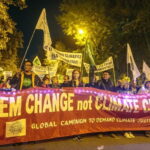Bangladesh, one of the world’s most climate-vulnerable countries, is witnessing a troubling rise in lightning-related deaths. Scientists point to a strong link between increased lightning activity and worsening air pollution, much of which is carried in from across its borders. A new study, which analyzed six years of lightning and air quality data (2015-20), has found a strong correlation between lightning frequency and elevated concentrations of airborne dust and sulfate particles. These pollutants peak during the pre-monsoon months, particularly April and May — also the time when lightning strikes are most frequent. “We identified two major pollutants — dust and sulfate — that help create the right conditions for more lightning during Bangladesh’s pre-monsoon season,” says Ashraf Dewan, co-author of the study and an associate professor at Australia’s Curtin University. He explains that these pollutants act alongside atmospheric factors like Convective Available Potential Energy (CAPE), altering how clouds form and making it easier for electrical charges to build up inside storm clouds, ultimately leading to more lightning. The lightnings strike over Bangladesh, but these pollutant particles are not all homegrown. The study links the uptick in lightnings to the transport of large volumes of dust and sulfate aerosols from agricultural burning and industrial emissions in northern and western India, carried into Bangladesh by upper-level westerlies. The study found that, during peak lightning season, dust levels were 88% higher and sulfate levels 51% higher than during the secondary peak in August-September. However, Dewan stresses, this isn’t a simple “more pollution equals…This article was originally published on Mongabay
Search
Recent Research
Want your Blog Article featured on our website?
Research
Featured News
How to Make Your Home More Energy-Efficient in 2026
A practical, future-ready guide for lower bills and a smaller footprint Rising energy prices and
Sustainable Break Rooms: Greening the Office Pantry
Photo by Rodeo Project Management Software on Unsplash A break room may seem like a
Solar-powered AI streetlights to fund coastal highway construction
Nigeria’s long delayed Lagos-Calabar Coastal Highway is set to be rescued by thousands of AI-driven,
Big Data Analytics Enhances Renewable Energy sector
The sun doesn’t send bills, but energy companies using renewable energy do. And to keep
From COP30 to Sri Lanka, indigenous voices shape climate & food sovereignty
COLOMBO — When Indigenous groups converged at the entrance of the U.N. Climate Change Conference
Another threat to reefs: Microplastic chemicals may harm coral reproduction
As the sliver of a new moon shines over Kāneʻohe Bay, Oʻahu, millions of tiny
A Practical Guide to Choosing the Right Organizer Bins Online
Choosing organizer bins sounds simple — until you start comparing sizes, materials, and specs online.
How Lagos traders struggle as styrofoam gradually disappears in markets
Traders have continued to count their losses about five months after the Lagos State Government





